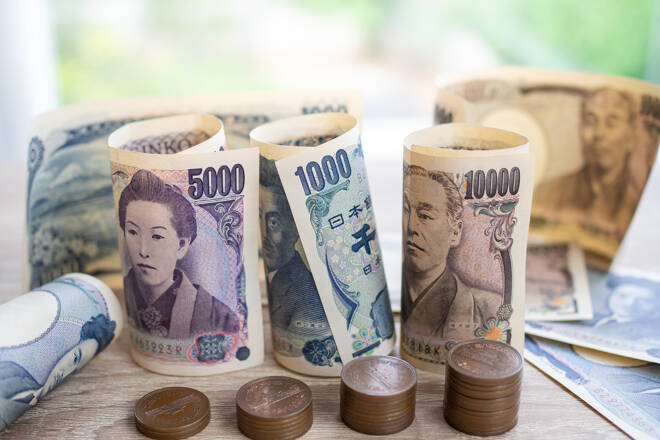Advertisement
Advertisement
USD/JPY Forecast: 145 in View as Investors Eye Wages and BoJ Monetary Policy
By:
Key Points:
- The USD/JPY declined by 0.67% on Friday, ending the session at 147.053.
- Q4 GDP numbers from Japan drew investor interest early in the Monday session.
- Wage negotiations, Bank of Japan commentary, and US consumer inflation expectations also need consideration on Monday.
USD/JPY Movement on Friday
The USD/JPY declined by 0.67% on Friday. Following a 0.87% slide on Thursday, the USD/JPY ended the session at 147.053. The USD/JPY rose to a high of 148.116 before falling to a Friday session low of 146.478.
The Japanese Economy Expanded by 0.1% in Q4
On Monday, the Japanese economy was in the spotlight early in the session. Finalized GDP numbers for Q4 warranted investor attention.
In Q4, the economy expanded by 0.1% quarter-on-quarter versus a 0.7% contraction in Q3. Significantly, the economy performed better than expected. According to the preliminary report, the economy contracted by 0.1%.
Capital expenditure increased by 2.0% quarter-on-quarter, up from a preliminary 0.1% decline. However, private consumption declined by 0.3% quarter-on-quarter, down from a preliminary 0.2% fall.
The private consumption numbers may draw the interest of the Bank of Japan. The BoJ is eyeing wage growth and the services sector to drive demand-driven inflation. Softer private consumption figures would increase the focus on wage negotiations.
Nonetheless, sizeable wage hikes could support bets on a March BoJ pivot from negative rates. Investors will have access to the outcome of wage negotiations on March 15, several days before the BoJ monetary policy meeting.
With the Japanese economy in focus, investors must consider BoJ commentary. Views on the GDP Report, inflation, and timelines for a pivot from negative rates would move the dial.
US Economic Calendar: The US Jobs Report
On Monday, US consumer inflation expectations will be in focus. Economists forecast consumer inflation expectations to remain at 3.0%. Softer-than-expected numbers could support consumer confidence. Improving consumer confidence trends could fuel consumer spending and demand-driven inflation.
However, a weakening labor market backdrop could impact consumer spending trends more. Consumers tighten the purse strings in a deteriorating labor market environment, dampening demand-driven inflation.
The USD/JPY could be more sensitive to the report, with official US inflation numbers out on Tuesday. Significantly, softer inflation trends would boost expectations of an H1 2024 Fed rate cut.
Short-term Forecast
Near-term trends for the USD/JPY will hinge on US inflation numbers and wage negotiations in Japan. Softer US inflation and a hike in Japanese pay could tilt monetary policy divergence toward the Yen. The Fed is eyeing an H1 2024 rate cut. In contrast, wage hikes could raise bets on the BoJ exiting negative rates in March.
USD/JPY Price Action
Daily Chart
The USD/JPY remained below the 50-day EMA while holding above the 200-day EMA, sending bearish near-term but bullish longer-term price signals.
A USD/JPY move through the 148.405 resistance level and 50-day EMA would bring the 150.201 resistance level into play. Selling pressure could intensify at the 148.405 resistance level. The 50-day EMA (148.412) is confluent with the resistance level.
Wage negotiations, BoJ chatter, and US consumer inflation expectations need consideration.
However, a break below the 146.649 support level would give the bears a run at the 200-day EMA (145.465).
The 14-day RSI at 35.08 suggests a USD/JPY drop below the 146.649 support level before entering oversold territory.
4-Hourly Chart
The USD/JPY sat below the 50-day and 200-day EMAs, sending bearish near-term price signals.
A USD/JPY breakout from the 147.500 handle could give the bulls a run at the 148.405 resistance level.
However, a drop below the 146.649 support level would bring the 144.713 support level into view.
The 14-period 4-hour RSI at 19.48 shows the USD/JPY in oversold territory. Buying pressure could intensify at the 146.649 support level.
About the Author
Bob Masonauthor
With over 28 years of experience in the financial industry, Bob has worked with various global rating agencies and multinational banks. Currently he is covering currencies, commodities, alternative asset classes and global equities, focusing mostly on European and Asian markets.
Did you find this article useful?
Latest news and analysis
Advertisement
